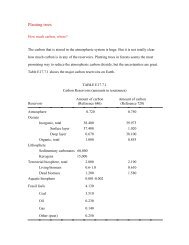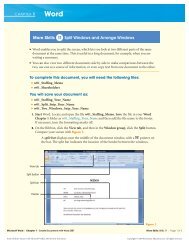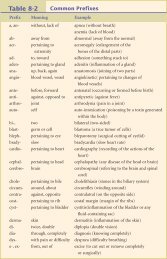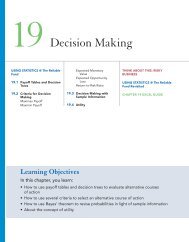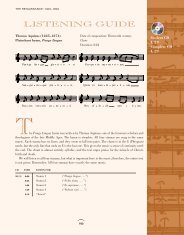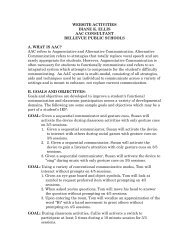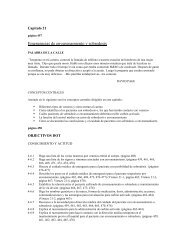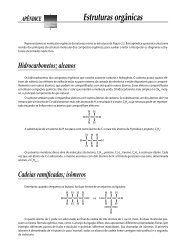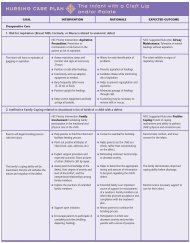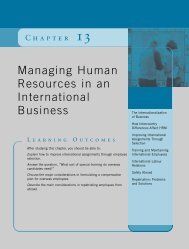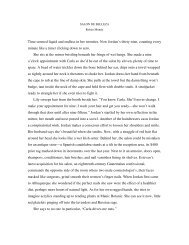chapter
chapter
chapter
Create successful ePaper yourself
Turn your PDF publications into a flip-book with our unique Google optimized e-Paper software.
idge segments. Here seafloor produced at one ridge axis<br />
moves in the opposite direction as seafloor is produced<br />
at an opposing ridge segment. Thus, between the ridge<br />
segments these adjacent slabs of oceanic crust are grinding<br />
past each other along a transform fault. Beyond the<br />
ridge crests are the inactive zones, which are preserved<br />
as linear topographic scars. These fracture zones tend to<br />
curve such that small segments roughly parallel the direction<br />
of plate motion at the time of their formation.<br />
In another role, transform faults provide the means<br />
by which the oceanic crust created at ridge crests can be<br />
transported to a site of destruction, the deep-ocean<br />
trenches. Figure 7.16 illustrates this situation. Notice that<br />
the Juan de Fuca plate moves in a southeasterly direction,<br />
eventually being subducted under the West Coast<br />
of the United States. The southern end of this relatively<br />
small plate is bounded by the Mendocino transform<br />
fault. This transform fault boundary connects the Juan<br />
de Fuca ridge to the Cascade subduction zone (Fig-<br />
Juan<br />
de Fuca<br />
Ridge<br />
Pacific<br />
plate<br />
Transform fault<br />
Mendocino<br />
Fault<br />
Juan<br />
de Fuca<br />
plate<br />
Cascadia subduction zone<br />
Chapter 7 Plate Tectonics 211<br />
ure 7.16). Therefore, it facilitates the movement of the<br />
crustal material created at the ridge crest to its destination<br />
beneath the North American continent (Figure 7.16).<br />
Another example of a ridge-trench transform fault<br />
is found southeast of the tip of South America. Here<br />
transform faults on the north and south margins of the<br />
Scotia plate connect the trench to a short spreading axis<br />
(see Figure 7.8).<br />
Although most transform faults are located within<br />
the ocean basins, a few cut through continental crust.<br />
Two examples are the earthquake-prone San Andreas<br />
Fault of California and the Alpine Fault of New<br />
Zealand. Notice in Figure 7.16 that the San Andreas<br />
Fault connects a spreading center located in the Gulf of<br />
California to the Cascade subduction zone and the Mendocino<br />
transform fault located along the northwest<br />
coast of the United States. Along the San Andreas Fault,<br />
the Pacific plate is moving toward the northwest, past<br />
the North American plate. If this movement continues,<br />
Oregon<br />
California<br />
Mendocino<br />
Fault<br />
Relative motion of<br />
Pacific plate<br />
PACIFIC<br />
PLATE<br />
▲ ▲ ▲ ▲ ▲<br />
Juan<br />
de Fuca<br />
plate<br />
San Francisco<br />
Cascadia<br />
subduction<br />
zone<br />
San Andreas Fault<br />
Los<br />
Angeles<br />
Gulf of<br />
California<br />
NORTH<br />
AMERICAN<br />
PLATE<br />
Figure 7.16 The role of transform faults. The Mendocino transform fault permits seafloor generated at the Juan de Fuca ridge<br />
to move southeastward past the Pacific plate and beneath the North American plate. Thus, this transform fault connects a<br />
divergent boundary to a subduction zone. Futhermore, the San Andreas Fault, also a transform fault, connects two spreading<br />
centers—the Juan de Fuca Ridge and a divergent zone located in the Gulf of California.




